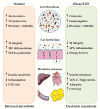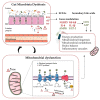Microbiota-Mitochondria Inter-Talk: A Potential Therapeutic Strategy in Obesity and Type 2 Diabetes
- PMID: 32927712
- PMCID: PMC7554719
- DOI: 10.3390/antiox9090848
Microbiota-Mitochondria Inter-Talk: A Potential Therapeutic Strategy in Obesity and Type 2 Diabetes
Abstract
The rising prevalence of obesity and type 2 diabetes (T2D) is a growing concern worldwide. New discoveries in the field of metagenomics and clinical research have revealed that the gut microbiota plays a key role in these metabolic disorders. The mechanisms regulating microbiota composition are multifactorial and include resistance to stress, presence of pathogens, diet, cultural habits and general health conditions. Recent evidence has shed light on the influence of microbiota quality and diversity on mitochondrial functions. Of note, the gut microbiota has been shown to regulate crucial transcription factors, coactivators, as well as enzymes implicated in mitochondrial biogenesis and metabolism. Moreover, microbiota metabolites seem to interfere with mitochondrial oxidative/nitrosative stress and autophagosome formation, thus regulating the activation of the inflammasome and the production of inflammatory cytokines, key players in chronic metabolic disorders. This review focuses on the association between intestinal microbiota and mitochondrial function and examines the mechanisms that may be the key to their use as potential therapeutic strategies in obesity and T2D management.
Keywords: gut microbiota; inflammation; mitochondria; mitochondrial oxidative/nitrosative stress; obesity; type 2 diabetes.
Conflict of interest statement
The authors declare no conflict of interest. The funders had no role in the writing of the manuscript.
Figures



References
-
- World Health Organization Obesity and Overweight. [(accessed on 22 June 2020)]; Available online: https://www.who.int/news-room/fact-sheets/detail/obesity-and-overweight.
-
- Abarca-Gómez L., Abdeen Z.A., Hamid Z.A., Abu-Rmeileh N.M., Acosta-Cazares B., Acuin C., Adams R.J., Aekplakorn W., Afsana K., Aguilar-Salinas C.A. Worldwide trends in body-mass index, underweight, overweight, and obesity from 1975 to 2016: A pooled analysis of 2416 population-based measurement studies in 1289 million children, adolescents, and adults. Lancet. 2017;390:2627–2642. doi: 10.1016/S0140-6736(17)32129-3. - DOI - PMC - PubMed
Publication types
Grants and funding
LinkOut - more resources
Full Text Sources

